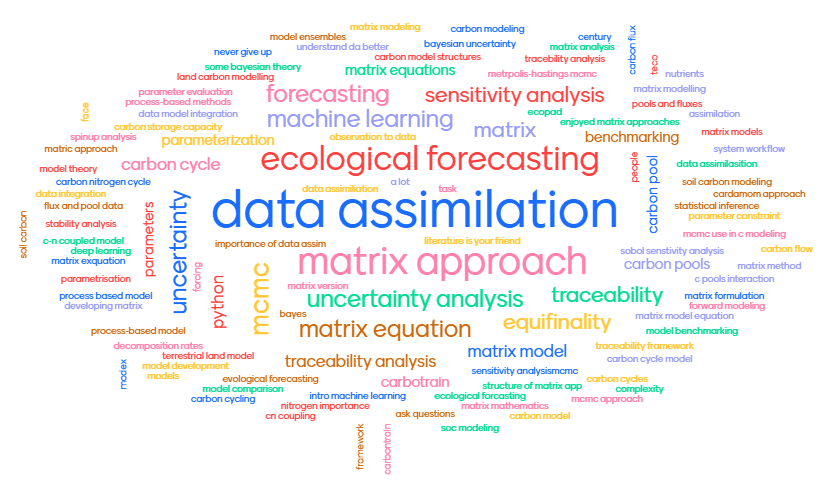For 10 days in late May, 150 land carbon modelers and experimentalists from throughout the world gathered in the Zoom “airspace” above NAU and defied time. To join this group (7 a.m. Arizona time, Monday-Friday,) on Zoom was to feel as if the global pandemic that halted in-person conferences and workshops for more than a year and introduced cultural concepts like “Zoom fatigue” had never occurred. The chat sidebar rolled with questions for the invited speakers. Participants from 26 countries and multiple time zones smiled as they discussed how best to represent the intricacies of the planet in computer programs designed to forecast Earth’s future. These models are built to answer the urgent questions: When and what will happen to ecosystems as the Earth becomes warmer?
The Fourth Training Course on New Advances in Land Carbon Cycle Modeling (or 4T), hosted by the lab of Yiqi Luo at the Center for Ecosystem Science and Society, has expanded and flourished since going virtual, broadening its access and reach to global modeling centers and home offices throughout the globe. Last year, for instance, the course welcomed 85 participants; this year, 153 applicants were accepted. Luo, who directs the course, is glad it’s available to more people and has made changes to the curriculum to include more types of scientists with different backgrounds.
“This year, we developed a software system for teaching that made it much easier for people to learn,” Luo said. “This software means that attendees don’t have to have as much modeling and programming background as they needed in previous years.”
He said the Earth system modeling community is vexed by a central issue: uncertainty. Uncertainty measures the imperfections of model outputs. In each of the agenda-setting Intergovernmental Panel on Climate Change (IPCC) reports, Luo said, “uncertainty has always been an issue.”
“We really need to understand the causes of that uncertainty to make a diagnosis,” he said. The matrix approach, one of the approaches he developed that is taught in 4T, functions as a “doctor” of land carbon cycle models. “Using the matrix approach, we can diagnose exactly what causes that problem.”
To apply the knowledge and techniques learned from 4T, nearly 30 volunteers from the training course formed a working group to doctor the sixth phase of the Coupled Model Intercomparison Project, or CMIP6, a global modeling effort to predict the future states of climate and ecosystems. Results from CMIP6 will inform IPCC’s sixth assessment report. Lifen Jiang, Luo’s colleague and coordinator of the course, said that one of the major draws to join the working group was the use of CMIP6. Beyond the course, the working group continues to collaborate on CMIP6 through a “learning by doing” practice to address some of the big questions the modeling community is tackling.
According to Luo, Jiang is at the heart of the training course and a major key to its success. Jiang corresponded with all participants as they registered, answered questions, delivered a lecture, and monitored the course’s Slack channel. “Without Lifen, we cannot organize this course,” Luo said. “She is so essential.”
Course attendees who were relatively new to modeling said Jiang and Luo created a welcoming and rigorous learning environment.
“I learned the fundamentals of land carbon cycle modeling and a deeper understanding of how carbon cycle models work,” said Lisa Haber, a Ph.D. student at Virginia Commonwealth University. Haber, who studies forest system ecology, hopes to use models to accurately simulate what happens to carbon during an ecological disturbance at her study site in northern Michigan. “Connecting with other graduate students, postdocs, early career scientists and even senior researchers who taught and guest-lectured in this course was an incredibly rich experience for me—one I would never have been able to access at my home institution.”
“This course really was my entry point into the whole modeling community,” said Bastian Buman, a Ph.D. candidate in the Remote Sensing Laboratories at the University of Zurich in Switzerland. Buman wants to combine remote sensing, modeling and in situ measurements to learn more about carbon cycles at the interface of land and aquatic ecosystems. “Both Lifen and Yiqi created a very welcoming and happy community. It’s always great to meet peers and people interested in similar topics, but during these stressful pandemic times, it is even more encouraging and motivating to connect with others.”Learn more about the Fourth Training Course on New Advances in Land Carbon Cycle Modeling at the Ecolab page.
Kate Petersen | Center for Ecosystem Science and Society




